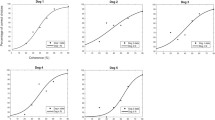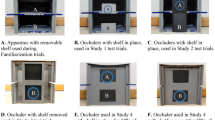Abstract
In several species, the ability to locate a disappearing object is an adaptive component of predatory and social behaviour. In domestic dogs, spatial memory for hidden objects is primarily based on an egocentric frame of reference. We investigated the geometric components of egocentric spatial information used by domestic dogs to locate an object they saw move and disappear. In experiment 1, the distance and the direction between the position of the animal and the hiding location were put in conflict. Results showed that the dogs primarily used the directional information between their own spatial coordinates and the target position. In experiment 2, the accuracy of the dogs in finding a hidden object by using directional information was estimated by manipulating the angular deviation between adjacent hiding locations and the position of the animal. Four angular deviations were tested: 5, 7.5, 10 and 15°. Results showed that the performance of the dogs decreased as a function of the angular deviations but it clearly remained well above chance, revealing that the representation of the dogs for direction is precise. In the discussion, we examine how and why domestic dogs determine the direction in which they saw an object disappear.





Similar content being viewed by others
References
American Kennel Club (1992) The complete dog book, 18th edn. Howell Book House, New York
Bennett ADT (1993) Spatial memory in a food-storing corvid. I. Near tall landmarks are primarily used. J Comp Physiol A 173:193–207
Bremner JG (1978a) Egocentric versus allocentric spatial coding in nine-month-old infants: factors influencing the choice of code. Dev Psychol 14:346–355
Bremner JG (1978b) Spatial errors made by infants: inadequate spatial cues or evidence of egocentrism? Br J Psychol 69:77–84
Brownell PH (1984) Prey detection by the sand scorpion. Sci Am 251:86–97
Cartwright BA, Collett TS (1982) How honeybees use landmarks to guide their return to a food source. Nature 295:560–564
Cartwright BA, Collett TS (1983) Landmark learning in bees. J Comp Physiol 151A:521–543
Chapuis N (1982) Référentiels spatiaux utilisés dans la réalisation d’un trajet inverse chez le chien. Annee Psychol 82:75–100
Chapuis N, Thinus-Blanc C, Poucet B (1983) Dissociation of mechanisms involved in dogs’ oriented displacements. Q J Exp Psychol 35B:213–219
Chapuis N, Varlet C (1987) Short cuts by dogs in natural surrounding. Q J Exp Psychol 39B:49–64
Cheng K (1986) A purely geometric module in the rat’s spatial representation. Cognition 23:149–178
Cheng K (1988) Some psychophysics of the pigeon’s use of landmarks. J Comp Physiol 162A:815–826
Cheng K (1989) The vector sum model of pigeon landmark use. J Exp Psychol (Anim Behav) 15:366–375
Cheng K (1990) More psychophysics of the pigeon’s use of landmarks. J Comp Physiol 166A:857–863
Cheng K (1994) The determination of direction in landmark-based spatial search in pigeons: a further test of the vector sum model. Anim Learn Behav 22:291–301
Cheng K (1998) Distances and directions are computed separately by honeybees in landmarks-based search. Anim Learn Behav 26:455–468
Cheng K, Sherry D (1992) Landmark-based spatial memory in birds (Parus atricapillus and Columba livia): the use of edges and distances to represent spatial positions. J Comp Psychol 106:331–341
Cheng K, Spetch ML (1998) Mechanisms of landmark use in mammals and birds. In: Healy S (ed) Spatial representation in animals. Oxford University Press, New York, pp 1–17
Collett TS, Cartwright BA, Smith BA (1986) Landmark learning and visuo-spatial memories in gerbils. J Comp Physiol 158A:835–851
Ellard CG, Goodale MA, Timney B (1984) Distance estimation in the Mongolian Gerbil: the role of dynamic depth cues. Behav Brain Res 14:29–39
Étienne AS, Joris-Lambert S, Dahn-Hurni C, Reverdin B (1995a) Optimizing visual landmarks: two- and three-dimensional minimal landscapes. Anim Behav 49:165–179
Étienne AS, Joris-Lambert S, Maurer R, Reverdin B, Sitbon S (1995b) Optimizing distal landmarks: horizontal versus vertical structures and relation to background. Behav Brain Res 68:103–116
Etienne AS, Berlie J, Georgakopoulos J, Maurer R (1998) Role of dead reckoning in navigation. In: Healy S (ed) Spatial representation in animals. Oxford University Press, New York, pp 55–68
Étienne AS, Teroni E, Hurni C, Portenier V (1990) The effect of a single light cue on homing behaviour of the golden hamster. Anim Behav 39:17–41
Fiset S, Doré FY (1996) Spatial encoding in domestic cats (Felis catus). J Exp Psychol (Anim Behav) 22:420–437
Fiset S, Beaulieu C, Landry F (2003) Duration of dogs’ (Canis familiaris) working memory in search for disappearing objects. Anim Cogn 6:1–10
Fiset S, Gagnon S, Beaulieu C (2000) Spatial encoding of hidden objects in dogs (Canis familiaris). J Comp Psychol 114:315–324
Gallistel CR (1990) The organization of learning. MIT Press, Cambridge, Mass.
Gould-Beierle K, Kamil A (1996) The use of local and global cues by Clark’s nutcrackers (Nicifraga columbiana). Anim Behav 52:519–528
Gould-Beierle K, Kamil AC (1998) Use of landmarks in three species of food-storing corvids. Ethology 104:361–378
Harrison R, Nissen HW (1941) Spatial separation in the delayed response performance of chimpanzees. J Comp Psychol 31:427–435
Kamil AC, Jones JE (1997) The seed storing corvid Clark’s nutcracker learns geometric relationships among landmarks. Nature 390:276–279
Kamil AC, Jones JE (2000) Geometric rule learning by Clark’s nutcrackers (Nucifraga columbiana). J Exp Psychol (Anim Behav) 26:439–453
Kelly DM, Spetch ML, Heth CD (1998) Pigeons’ (Columbia livia) encoding of geometric and featural properties of a spatial environment. J Comp Psychol 112:259–269
Jones JE, Kamil AC (2001) The use of relative and absolute bearings by Clark’s Nutcrackers, Nucifraga columbiana. Anim Learn Behav 29:120–132
Jones JE, Antoniadis E, Shettleworth S, Kamil AC (2002) A comparative study of geometric rule learning by nutcrackers (Nucifraga columbiana), pigeons (Columba livia), and jackdaws (Corvus monedula). J Comp Psychol 116:350–356
Margules J, Gallistel CR (1988) Heading in the rat: determination by environmental shape. Anim Learn Behav 16:404–410
Nadel L (1990) Varieties of spatial cognition: psychobiological considerations. In: Diamond A (ed) The development and neural bases of higher cognitive functions. Academic Press, New York, pp 613–626
Neiworth JJ, Steinmark E, Basile BM, Wonders R, Steely F, DeHart C (2003) A test of object permanence in a new-world mondey species, cotton top tamarins (Saguinus oedipus). Anim Cogn 6:27–37
O’Keefe J, Nadel L (1978) The hippocampus as a cognitive map. Clarendon, Oxford, England
Pick HL, Lockman JJ (1981) From frames of reference to spatial representations. In: Liben LS, Patterson AH, Newcombe N (eds) Spatial representation and behavior across the life span: theory and application. Academic Press, New York, pp 39–61
Séguinot V, Cattet J, Benhamou S (1998) Path integration in dogs. Anim Behav 55:787–797
Siegal S, Castellan NJ (1988) Nonparametric statistics for behavioural sciences. 2nd edn. McGraw-Hill, New York
Sovrano VA, Bisazza A, Vallortigara G (2002) Modularity and spatial information reorientation in a simple mind: encoding of geometric and nongeometric properties of spatial environment by fish. Cognition 85:51–59
Sovrano VA, Bisazza A, Vallortigara G (2003) Modularity as a fish views it: conjointing geometric and nongeometric information for spatial reorientation. J Exp Psychol (Anim Behav) 29:199–210
Spetch ML (1995) Overshadowing in landmark learning: touch-screen studies with pigeons and humans. J Exp Psychol (Anim Behav) 21:166–181
Spetch ML, Mondlock MV (1993) Control of pigeons’ spatial search by graphic landmarks in a touch-screen task. J Exp Psychol: Anim Behav Proc 19:353–372
Spetch ML, Cheng K, Mondlock MV (1992) Landmark use by pigeons in a touch-screen spatial search task. Anim Learn Behav 20:281–292
Spetch ML, Cheng K, MacDonald SE (1996) Learning the configuration of a landmark array, I: touch-screen studies with pigeons and humans. J Comp Psychol 110:55–68
Spetch ML, Cheng K, MacDonald SE, Linkenhoker BA, Kelly DM, Doerkson SR (1997) Learning the configuration of a landmark array in pigeons and humans. II. generality across search tasks. J Comp Psychol 111:14–24
Tolman EC (1948) Cognitive maps in rats and men. Psychol Rev 55:189–208
Thinus-Blanc C (1996) Animal spatial cognition: behavioral and neural approaches. World Scientific, Singapore
Tomlinson WT, Johnson TD (1991) Hamsters remember spatial information derived from olfactory cues. Anim Learn Behav 9:135–139
Vallortigara G, Zanforlin M, Pasti G (1990) Geometric modules in animals’ spatial representation: a test with chicks (Gallus gallus domesticus). J Comp Psychol 104:248–254
Vargas JP, Lopez JC, Salas C, Thinus-Blanc C (2004) Encoding of geometric spatial information by Goldfish (Carassius auratus). J Comp Psychol 118:206–216
Wallace GK (1959) Visual scanning in the desert locust Schistocera gregaria Foskal. J Exp Biol 36:512–525
Wehner R, Michel B, Antonsen P (1996) Visual navigation in insects: coupling of egocentric and geocentric information. J Exp Biol 199:129–140
Acknowledgements
This research was supported by an operating research grant from the Natural Sciences and Engineering Research Council of Canada and by a research grant from the Faculté des Études Supérieures et de la Recherche of the Université de Moncton. The experiments received approval from the Comité de Protection des Animaux from the Faculté des Etudes Supérieures et de la Recherche of the Université de Moncton, which is responsible for the application and enforcement of rules of the Canadian Council on Animal Care. We thank the owners of the dogs who participated in these experiments
Author information
Authors and Affiliations
Corresponding author
Rights and permissions
About this article
Cite this article
Fiset, S., Landry, F. & Ouellette, M. Egocentric search for disappearing objects in domestic dogs: evidence for a geometric hypothesis of direction. Anim Cogn 9, 1–12 (2006). https://doi.org/10.1007/s10071-005-0255-1
Received:
Revised:
Accepted:
Published:
Issue Date:
DOI: https://doi.org/10.1007/s10071-005-0255-1




